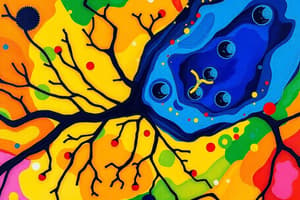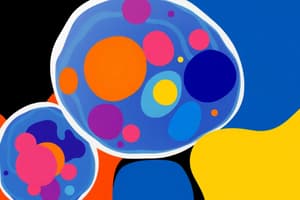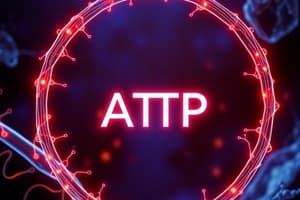Podcast
Questions and Answers
Which of the following are components of the inner mitochondrial membrane?
Which of the following are components of the inner mitochondrial membrane?
- Outer membrane
- Boundary membranes (correct)
- Cristae (correct)
- Cristia junction (correct)
Mitochondrial DNA (mtDNA) is linear like nuclear DNA.
Mitochondrial DNA (mtDNA) is linear like nuclear DNA.
False (B)
What molecule is produced when ADP combines with inorganic phosphate?
What molecule is produced when ADP combines with inorganic phosphate?
ATP
Match the following processes with their descriptions:
Match the following processes with their descriptions:
The primary site for aerobic respiration is the ______.
The primary site for aerobic respiration is the ______.
What is the primary energy molecule in cells?
What is the primary energy molecule in cells?
Fission in mitochondria helps in removing damaged parts.
Fission in mitochondria helps in removing damaged parts.
Which process occurs first during glucose oxidation?
Which process occurs first during glucose oxidation?
What are the end products of the citric acid cycle?
What are the end products of the citric acid cycle?
What does NAD carry in oxidation/reduction reactions?
What does NAD carry in oxidation/reduction reactions?
Glycolysis occurs in the mitochondrial matrix.
Glycolysis occurs in the mitochondrial matrix.
Flashcards are hidden until you start studying
Study Notes
Mitochondria Structure
- Mitochondria are the powerhouses of the cell, responsible for ATP production
- Outer membrane allows small molecules to pass through via porins
- Inner membrane contains proteins for oxidative phosphorylation, including ATP synthase, electron transport proteins, and transport proteins
- Intermembrane space lies between the inner and outer membranes, continuous with the lumen of the cristae
- Matrix is the central compartment within the inner membrane, containing mitochondrial DNA (mtDNA)
Mitochondrial DNA (mtDNA)
- Circular DNA, resembling bacterial DNA, located in the matrix
- Codes for proteins essential for mitochondrial function (e.g., Tim, electron transport proteins), ribosomes, and transfer RNAs (tRNA)
- Most mitochondrial proteins are coded by nuclear DNA, synthesized in the cytosol, and transported into the mitochondria
Mitochondrial Dynamics
- Mitochondria exist as a tubular and branched network, constantly changing
- Fusion merges two mitochondria into one, promoting homogeneity within the cell
- Fission fragments damaged or mutated mitochondrial parts, which are removed by autophagy, or separates them for cell division and transport
ATP Production
- ATP (adenosine triphosphate) is the cellular energy currency composed of adenine, ribose, and three phosphate groups
- ATP is primarily generated by aerobic respiration in mitochondria, with minimal amounts produced by glycolysis
- Glucose breakdown is central to both catabolic (breaking down) and anabolic (building up) pathways
- Glucose is broken down into pyruvate during glycolysis
- Pyruvate is converted to acetyl CoA, which fuels the citric acid cycle
- Other molecules like fats, proteins, and carbohydrates can also be broken down to feed into this pathway
- Glucose can be stored as glycogen (in animals) or starch (in plants)
- Glycolysis provides substrates for nucleotide synthesis, while acetyl CoA can be used to make fatty acids and phospholipids
Stages of Glucose Oxidation
- Glycolysis: Occurs in the cytosol, producing a small amount of ATP and NADH, and breaking down glucose into two pyruvate molecules
- Citric Acid Cycle (Krebs Cycle): Takes place in the mitochondrial matrix, producing NADH, FADH2, and some ATP from the breakdown of two pyruvates
- Electron Transport Chain: Embedded in the inner mitochondrial membrane, uses NADH and FADH2 to generate a proton-motive force – an electrochemical gradient of H+ across the inner membrane into the intermembrane space
- ATP Synthesis: Utilizes the ATP synthase enzyme and the proton-motive force to phosphorylate ADP to ATP by allowing protons to flow back into the matrix
Overall Result of Glucose Oxidation
- Approximately 38 ATP molecules are produced per glucose molecule during aerobic respiration
Studying That Suits You
Use AI to generate personalized quizzes and flashcards to suit your learning preferences.




